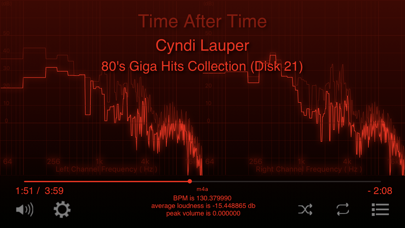
MusicFreq app for iPhone and iPad
Developer: junichi sakonaka
First release : 24 Sep 2017
App size: 18.28 Mb
MusicFreq is a music player.
MusicFreq analyzes the audio data of the DRM Free music being played and visualizes it in a real-time frequency spectrum graph.
The graph is displayed when playing DRM-free (unprotected) music files such as mp3, m4a, and aiff that have been synced to the iOS Music app library and downloaded to the device using a Mac or Windows computer.
Music purchased from AppleMusic or iTunesStore is in m4p (AAC) format protected by DRM (Apple FairPlay). Please note that protected audio files and cloud items will not be displayed in the graph. (Music can still be played.)
Graphs can be customized as line, scatter, and bar graphs.
The screen color changes to the same color as the album artwork of the music being played.
You can control music with tap, long tap, left and right swipe.
Display the simplified setting menu with the upper swipe.
You can quickly change the basic color of the screen to your favorite color with few operations.
Screen rotation is automatic and can be displayed and operated in both portrait and landscape.
MusicFreq controls the iOS system player, so the music to be played is shared with the music library of the iOS Music App, the music controller widget in the lock screen and the control center, the equalizer for the music in the settings app. You can also use the timer stop setting within the settings app to stop playback.
It is also possible to remotely control the player from a Blutooth device.
Function
FFT (Fast Fourier Transform) of voice data and high frequency real time display of frequency spectrum graph
MP3 BPM (Beat Per Minutes) analysis and title string blink animation (Only MP3 is enabled on iOS13 and iOS14, but M4A is also enabled on iOS15)
Title string morphing animation
Album artwork display
Forced screen rotation lock operation
Reproduction of iTunes playlist folder hierarchy
Automatic scale expansion/contraction for MP3 in linear scale graph display
Player operation
Tap: Play / Pause
Swipe left / right: Back / forward
Long tap on left / right area of screen: fast reverse / fast forward
Seek bar (slider) tap: Move to any playback time position
Swipe up: Display customization menu
Swipe down: Display song list
Two finger swipe left and right : Change graph type
Two finger swipe up and down : Change graph granularity
Two finger rotation : Change graph layout
Pinch-in: Logarithmic scale
Pinch out: Linear scale
Graph customization
Select from 5 types: line graph, scatter diagram, bar graph (short, long, dotted line)
Audio stereo channel left / right graph independent, right channel graph reversed left / right, left / right mixed drawing
Graph peak hold, descent, rise, and bound display
Automatic adjustment of graph drawing timing (Automatic audio delay matching with Bluetooth audio device connection, manual adjustment is also possible)
Adjustment of drawing display information amount
Adjustment of drawing update speed
Change color (customize menu)
Linear scale / logarithmic scale graph display change
Notes
All audio files in the music library can be played, but only DRM-free (unprotected) files such as mp3 and m4a can be displayed as a graph.
Also, cloud items cannot be analyzed on the device and will not be displayed in graphs, so please download them to the device using a genuine iOS music app.
You cannot add DRM-free music files to your library on only device such as an iPhone iPad or iPod Touch.
You need a Mac or Windows Computer to load DRM-free (unprotected) music files such as mp3s and m4a into your iOS Music App library.
Animation and frequent, high-definition graph drawing are expensive.
Frequent music change operations with high load settings can cause the device to heat up and consume significant power.
Pay attention to the remaining battery power.
If the iOS Music App is displayed when you try to start MusicFreq, start playback with the iOS Music App and then try starting MusicFreq.



